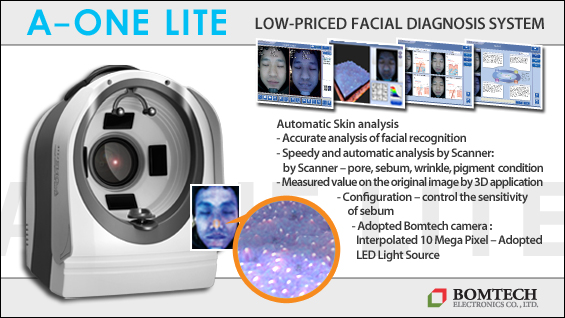▶ Previous Artlcle :#9. Development of Hair Removal Lasers I
As described in the previous article, the first hair removal laser, long pulse ruby laser (Palomar), was launched in 1996, immediately followed by long pulse alexandrite lasers and diode lasers. These lasers with different mechanical property but similar mechanism of action were introduced merely in 1-2 years.
[Advertisement] A-One LITE(Facial Diagnosys System) – Manufacturer: BOMTECH(www.bomtech.net)
There is a reason why such a variety of hair removal lasers could be introduced in the market so quickly. At that time, both Cynosure and Candela were interested in lasers for destroying thick blood vessels. As a standard vascular laser, 585-nm dye laser did not provide a long pulse duration and because of high scattering rate on the skin, it was difficult to deliver the energy deeper in the skin with 585nm dye laser. Dye laser would be appropriate for removing thin blood vessels, such as nevus flammeus and capillaries present close to the skin surface, but not for thick blood vessels. Since the removal of varicose veins or thick blood vessels for cosmetic purpose is common in Caucasian, lasers that could remove thick blood vessels without side effects were promising in the market. Study on the laser for thick blood vessels was therefore one of the recurrent themes for laser manufacturers and institutions. Long pulse alexandrite laser or long pulse diode laser with a deeper penetration depth and longer pulse durations appropriate for thick blood vessels had been studied as an alternative for dye laser. When ruby laser with similar property was introduced in the market for hair removal, however, other companies quickly followed the path by switching their vascular lasers under development to hair removal lasers. LPIR (Cynosure) and Gentlelase (Candela) are the examples of these hair removal lasers.
LPIR is an alexandrite laser with maximum fluence of 40 J/cm² and pulse duration of 5, 10 and 20 ms, of which the earliest model did not come with a skin cooling system. Gentlelase (Candela) is a long pulse alexandrite laser with pulse duration of 3 ms, equipped with dynamic cooling device.
Although there have been hundreds of hair removal lasers and IPL systems developed and marketed in or withdrawn from the market, knowledge of the history of hair removal lasers manufactured by Cynosure and Candela, Lightsheer diode lasers and long pulse Nd:YAG lasers would be most essential for understanding the overall development of hair removal lasers. Other hair removal lasers could be considered as modified, upgraded or cheaper versions of these lasers.
1. Cynosure
In 1997, Cynosure launched a long pulse alexandrite laser (long-pulse infrared laser, LPIR), which had been under development for vascular lesions, as a hair removal laser. Since it had been under development for vascular lesions, it was first approved by the FDA for vascular use but mainly sold for hair removal. As mentioned earlier, despite its weakness – no skin cooling system, it could compete with Candela’s Gentlelase because of its superiority in the pulse duration (5, 10 and 20 ms). Skin cooling system could not be attached to the first model because the company did not obtain the patent for skin surface cooling systems. Apogee model, which is still in the market, was first released on June 4, 1998. The model was soon equipped with a skin cooling system using cool air by Zimmer (German) and followed by various models with broader irradiation area and modified mechanical properties. Elite and Elite MPX models have been recently added to allow multiple options for pulse duration and spot size and to facilitate combination with long-pulse Nd:YAG. These two lasers have been particularly preferred because they can be used for vascular and pigmented lesions as well as for hair removal.
2. Candela
In 1997, Candela released Gentlelase, a 3-ms pulse duration alexandrite laser. This laser seemed less suitable for hair removal in terms of the pulse duration compared to Cynosure’s LPIR, but was meaningful in that it had DCD for a skin cooling system. After that, Gentlelase Plus with a wider spot size (18 mm) was released on September 22, 1999, followed by Gentlelase mini and more recently GentleMax, which was equipped with both long-pulse alexandrite and long-puse Nd:YAG, in addition to DCD, similar to Cynosure’s Elite (for decades, the two companies have been releasing lasers that are very similar in basic specs so that it is hard to distinguish which company is following which, possibly because they were established by the same person).

GenlteLase & Gentlemax light.
3. Lightsheer
The name ‘Lightsheer’ was used for the title because this hair removal laser has not been developed or sold by a single company. Since producing the long pulse ruby laser ‘Epilaser’, the first hair removal laser, in 1996, Palomar gained FDA’s approval for marketing the long-pulse diode laser ‘LightSheer’ for hair removal in December 1997. LightSheer was manufactured by Star Medical, a subsidiary company of Palomar (Appendix 1) and was marketed by Coherent. In 1999, Coherent merged Star Medical to form Coherent Star, by which LightSheer continued to be manufactured and marketed. Coherent Star changed the company name later to Coherent Medical Group, which was acquired by ESC/Sharplan in 2001 and turned into Lumenis. As a result, LightSheer has been manufactured by Lumenis since 2001.

Handpiece of SC, the first model of LightSheer
-To be continued-
▶ Next Artlcle : #10-2. Development of Hair Removal Lasers II





















